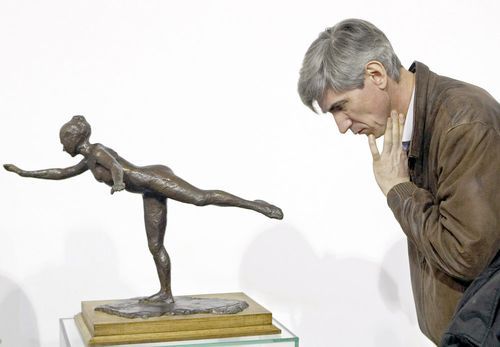3D poetry, monetary prose
Exhibition “100 Masterpieces of World Sculpture” opened at Mystetsky Arsenal
An old friend of Mystetsky Arsenal, famous Kyiv collector Ihor Voronov made a grand cultural event for Kyiv residents by presenting his collection of sculptures (it should be noted that this collection has fueled sculpture exhibition at 10-12 Lavrska Street before).
One hundred art works, 20 sculptures – the list of names is worthy of some encyclopedia: Auguste Rodin, Aristide Maillol, Amedeo Modigliani, Henry Moore, Hans Arp, Alexander Archipenko, Constantin Brancusi, Rembrandt Bugatti, Paul Gauguin, Salvador Dali, Edgar Degas, Alberto Giacometti, Diego Giacometti, Chana Orloff, Pablo Picasso, Auguste Renoir, Ossip Zadkine, and Jacques Lipchitz.
They all have different biographies, made different contribution to the art, but even for the smallest statuette of any of those authors collectors and auctioneers are willing to give any money. Two of the twenty – Archipenko and Orloff, are connected with Ukraine. It is known that Archipenko was born in Kyiv but then at the age of 19 he moved first to Moscow, then to Paris, and eventually settled in the United States, where he became famous. Orloff was born in the city of Starokostiantyniv in Volyn province and gained recognition in France as one of the brightest representatives of the Paris school.
“100 Masterpieces” is a brief tour to the modern history of arts. Almost all the sculptors presented at the exhibition were innovators, pioneers, starting from Auguste Rodin, who freed the art of sculpture from the dictates of the pedestal and also gave it plastic freedom not known before. His contemporaries did not understand him, his art gained recognition only towards the end of his life, and most of the sculptures became iconic images. These sculptures are presented at the exhibition, including The Thinker easily recognized by school students, The Kiss (maybe the best embodiment of sensuality in art), and The Cathedral – two hands folded in an arch. Rodin best described his sculpture The Thinker: “My Thinker thinks not only with his brain, with his frowning eyebrows, expanding nostrils, and tighten lips, but also with every muscle of his hands, back, and legs, with clenched fist and clenched toes.”
Rodin paved the way for many that came after him, although he never had disciples. The most interesting part of the exhibition are the works of the artists, who are most known as painters. It turns out that almost all the famous impressionists left sculptural heritage. For example, the exhibition features stylizations of pagan idols by Paul Gauguin – Stella of the Christ, Moon and Earth. Amedeo Modigliani is presented by his sculpture of a head of a woman with a narrow face similar to faces of women he painted. Edgar Degas did not consider sculpture to be a serious occupation and his numerous statuettes of horses and dancers look like 3D sketches for paintings depicting those horses and ballerinas, even though they are as expressive as the latter. From Renoir’s sculptures the visitors of the exhibition will be able to see quite realistic sculpture of Child’s Head and Girl with Drapery, from Picasso – flat gold trinkets and cubist bust. It is quite obvious that the “true” sculptors – fan of folk art Romanian artist Constantin Brancusi, obsessed with antiquity Aristide Maillol, Dadaist hooligan Hans Arp, surrealist Alberto Giacometti, artist of Ukrainian origin Archipenko, and, of course, great British artist Henry Moore, are obviously more masterful than the mentioned geniuses of painting, because they think in terms of dimensional categories. This dimensional structure of mind allowed Moore to create art works worthy of Rodin.
The lion’s share of the exhibits are made of bronze. The issue of originality of such works is always somewhat ambivalent: usually these are not the artifacts made by the author but rather the recent copies, cast from original forms and certified by copyright holders. Sculptures of Rodin, Gauguin, or Maillol are presented in such a way. However, a film released even in thousands copies does not cease to be an original creation of a specific film director. Thus, these are the creations of Rodin and Maillol.
It is a pleasant fact that among the “100 Masterpieces” there are quite a few stone sculptures, the art pieces that exist only in one original copy: Rodin’s Girl sculpture, Maillol’s Woman laying in Marble, women’s heads (Princess X, Mademoiselle Gentile and I) and impressive Dolphin by Brancusi, Abstraction by Lipchitz, Pink Torso by Jean Arp, Vertical Stone by Moore, and, finally, Lying Female Figure, Flat Torso, and Torso in Space by Archipenko, for sure, make the exhibition an outstanding art event and Voronov’s collection priceless.
Finally, it should be noted that the vernissage is also a philanthropic project. Voronov gave his collection to support the development of the complex: the funds raised from selling the tickets to the exhibition will be given to Mystetsky Arsenal, which, like all cultural institutions subordinated to state, has chronic problems with financing.
Exhibition “100 Materpices of World Sculpture” will be open until May 12.






